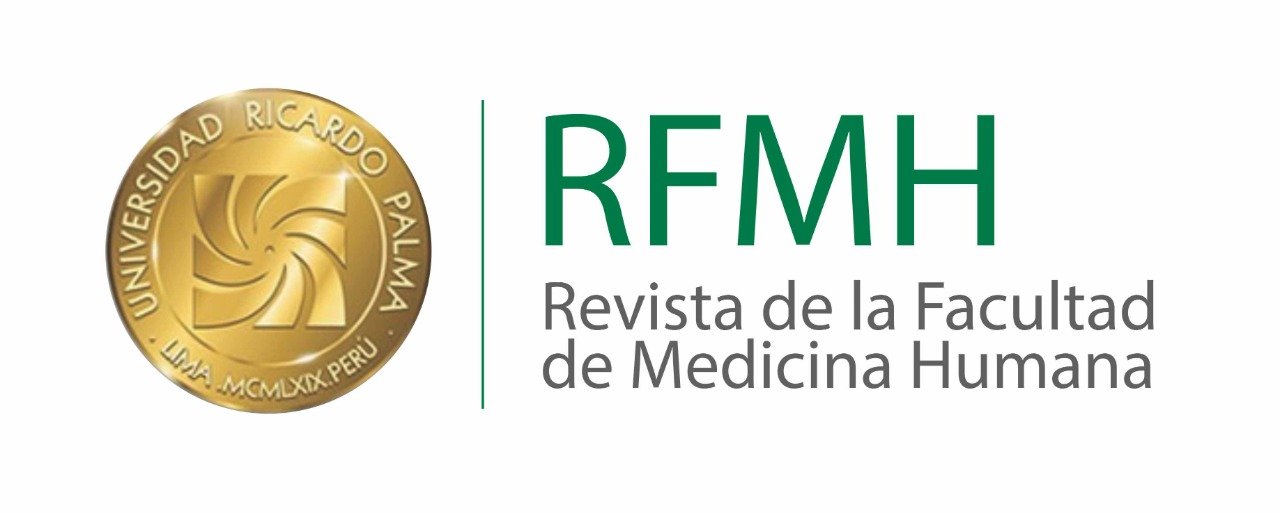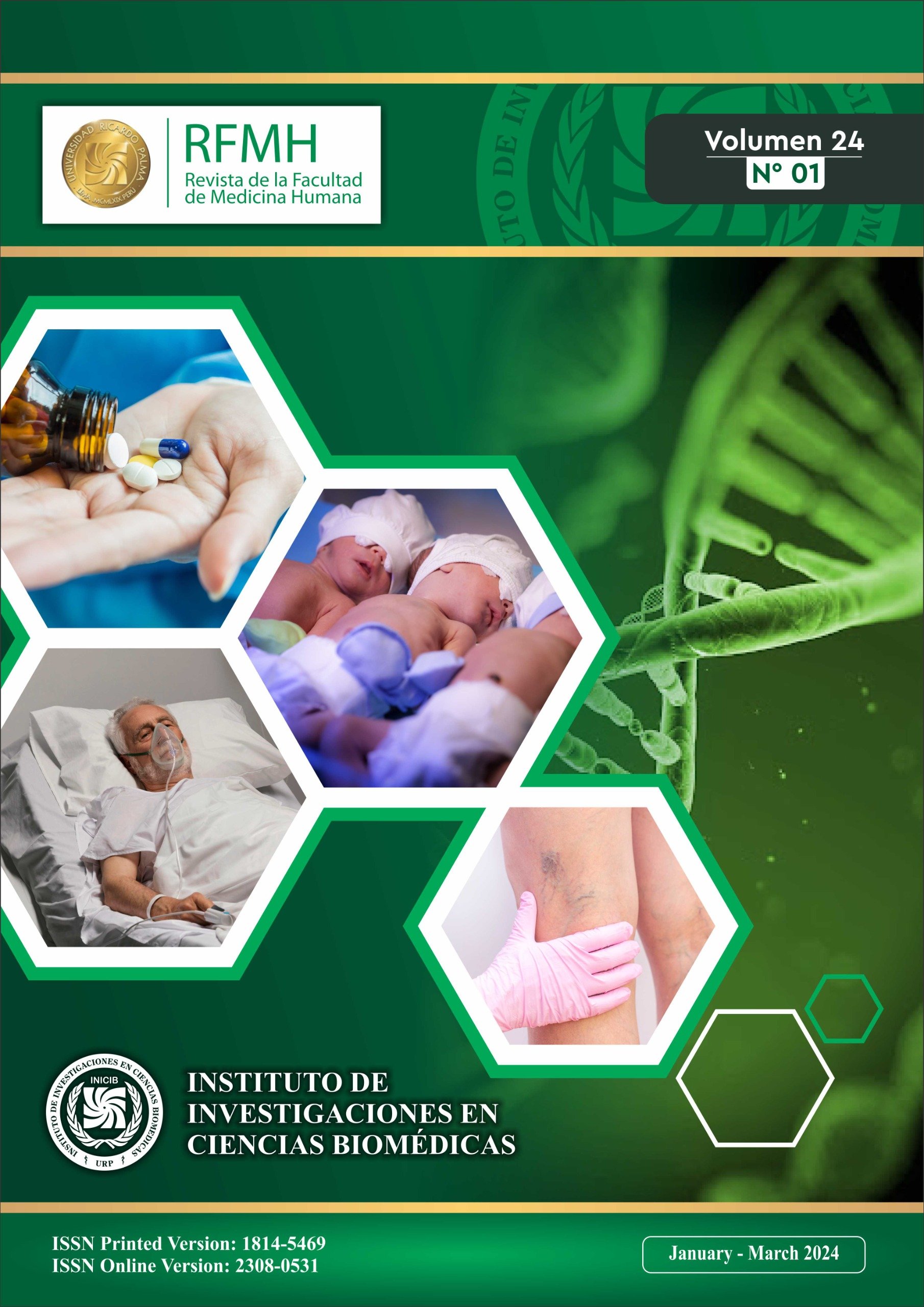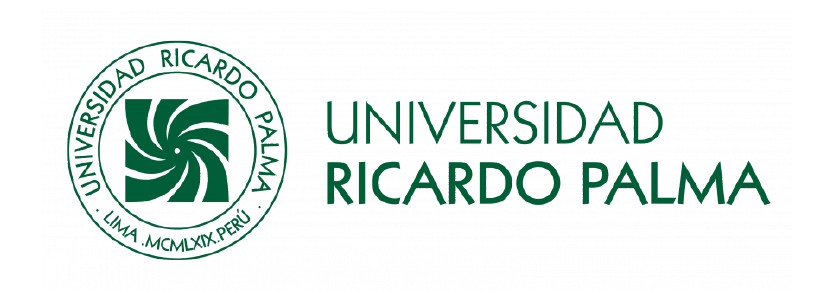SÍNDROME DE BURNOUT EN MÉDICOS DE UN HOSPITAL DE LA AMAZONÍA PERUANA
BURNOUT SYNDROME IN PHYSICIANS OF A HOSPITAL IN THE PERUVIAN AMAZON
DOI:
https://doi.org/10.25176/RFMH.v19i4.2220Palabras clave:
Agotamiento Profesional, Médicos, Relaciones Médico-PacienteResumen
Objetivo: Determinar el Síndrome de Burnout (SBO) en médicos cirujanos de los consultorios externos de un hospital de la Amazonía peruana. Métodos: Estudio transversal analítico; que incluyó a 30 médicos cirujanos que atendieron en los consultorios externos de las especialidades de Medicina, Cirugía, Gineco-Obstetricia y Pediatría del Hospital Regional de Pucallpa, determinando el agotamiento profesional mediante el Inventario de Burnout de Maslach (MBI) y la percepción de la relación médico paciente mediante la escala PREMEPA. Se emplearon modelos lineales generalizados para evaluar razones de prevalencia cruda y ajustada. Resultados: El 76,7% de los médicos fueron varones, ocho de cada diez padecieron SBO. El 20% de los pacientes estuvieron satisfechos con la consulta y sólo el 16,7% indicó tener una mediana relación médico paciente. Se encontró asociación estadísticamente significativa entre quienes padecían SBO y se atendieron en las consultas externas de los servicios de cirugía (RPa: 1.46; IC 95%: 1.20–1.76) , gineco obstetricia (RPa: 1.69; IC 95%: 1.41–2.03) o en aquellos pacientes que se encontraban insatisfechos con la consulta brindada (RPa: 1.59; IC 95%: 1.22-2.07), el haber realizado el residentado médico fue un factor protector a desarrollar SBO (RPa: 0.62; IC 95%: 0.62–0.77). Conclusión: Los pacientes manifiestan tener niveles adecuados de relación médico-paciente a pesar del
elevado índice de SBO en médicos, las especialidades quirúrgicas predisponen a desarrollar Burnout.
Descargas
Citas
2. Kim MH, Mazenga AC, Simon K, Yu X, Ahmed S, Nyasulu P, et al. Burnout and self-reported suboptimal patient care amongst health care workers providing HIV care in Malawi. PLoS One. 2018;13(2):e0192983.
3. Saijo Y, Chiba S, Yoshioka E, Kawanishi Y, Nakagi Y, Ito, T et al. Job stress and burnout among urban and rural hospital physicians in Japan. Aust J Rural Health. 2013;21(4):225-231
4. Maslach C, Jackson SE, Leiter MP. Maslach Burnout Inventory Manual. 4th ed Menlo Park, CA: Mind Garden Inc; 2016.
5. Carlin M. El síndrome de burnout: Evolución histórica desde el contexto laboral al ámbito deportivo. Anales de psicología, 2010; 26(1), 169.
6. Dávila FA, Nevado N. Validación de Burnout screening inventory en personal de formación del área de la salud. Educación Médica, 2016; 17(4), 158-63.
7. Stavroula Leka. La organización del trabajo y el estrés. OMS. 2014. https://www.who.int/occupational_health/publications/pwh3sp.pdf?ua=1
8. Rosende M, Kesque J, Romero MB, Rosende MC, Nelida-Severino M. Síndrome de Burnout: Padecimiento en instituciones públicas. 2009
9. Arrogante Ó. Mediación de la resiliencia entre burnout y salud en el personal de Enfermería. Enfermería Clínica, 2014. 24(5): 283-9.
10. Roldán, A. M. A., & Barriga, A. M. Q. Síndrome por quemarse en el trabajo y variables familiares y laborales de los médicos generales de Bogotá. Una estrategia de calidad laboral. Revista Colombiana de Psiquiatría, 44(4), 2015; 198-205.
11. Devi S. Doctors in distress. Lancet. 2011;377:454-5
12. Maticorena-Quevedo J, Beas R, Anduaga-Beramendi A, Mayta-Tristán P. Prevalencia del síndrome de burnout en médicos y enfermeras del Perú, Ensusalud 2014. Rev Peru Med Exp Salud Publica. 2016;33(2):241-7
13. Kumar S. Burnout and Doctors: Prevalence, Prevention and Intervention. Healthcare 2016, 4(3), 37
14. Gil-Monte P. Validez factorial de la adaptación al español del Maslach Burnout Inventory General Survey. Salud Publica Mex. 2002; 44: 33-40.
15. Cáceres-Mejía B, Roca-Quicaño R, Torres M, Pavic-Espinoza I, Mezones-Holguín E, Fiestas F. Análisis factorial del "Cuestionario para la evaluación del síndrome de quemarse por el trabajo" en estudiantes de medicina peruanos. Rev Psiquiatr Salud Ment (Barc.). 2013. Disponible en: http://dx.doi.org/10.1016/j. rpsm.2013.06.002.
16. Nakandakari MD, De la Rosa DN, Failoc-Rojas VE, Huahuachampi KB, Nieto WC, Gutiérrez AI, et al. Síndrome de burnout en estudiantes de medicina pertenecientes a sociedades científicas peruanas: Un estudio multicéntrico. Rev Neuropsiquiatr. 2015;78(4): 203-210.
17. Vásquez-Manrique JF, Maruy-Saito A, Verne-Martín E. Frecuencia del síndrome de burnout y niveles de sus dimensiones en el personal de salud del Servicio de Emergencia de Pediatría del Hospital Nacional Cayetano Heredia en el año 2014. Lima, Perú. Rev Neuropsiquiatr. 2014; 77 (3): 168-174.
18. Ramos R. Percepción de las relaciones médico-paciente por parte de los usuarios externos del Departamento de Medicina del Hospital Carrión, Callao-Perú Lima; 2008
19. Núñez-Morales R, Arias-Cornejo M, Sánchez-Sánchez N, Hernández-Porras T, Bustamante-Bravo V, Reupo-Vallejos M et al. Relación médico-paciente desde la perspectiva del paciente en el Hospital Nacional Almanzor Aguinaga Asenjo 2014. Rev. Exp. Med. 2015; 1 (1); 20-4
20. Vilchez-Cornejo J, Huamán-Gutiérrez R, Arce-Villalobos L, Morán-Mariños C, Mihashiro-Maguiña K, Melo-Mallma N et all. Síndrome de burnout en estudiantes de medicina: frecuencia, características y factores asociados. Act Med Per, 2016. 33(4):282-8.
21. Reyes-Ticas A, Medina MT, Mesa X, Paredes Y, Barahona Y, Sierra M. Estudio de síndrome de Burnout, depresión y factores asociados en los practicantes internos del Hospital Escuela. Rev Fac Cienc Med. 2012; 9(1): 14-30.
22. Miyoshi R, Matsuo H, Takeda R, Komatsu H, Abe H, Ishida Y. Burnout in Japanese residents and its associations with temperament and character. Asian J Psy. 2016; 24: 5-9.
23. Nobre de Novais R, Rocha LM, Eloi RJ, Dos-Santos LM, Moura MV, Ribeiro R et all. Burnout síndrome prevalence of on-call surgeons in a trauma reference hospital and its correlation with weekly workload: cross-sectional study.
24. Dueñas M, Merma L. Prevalencia de Burnout en médicos de la ciudad de Tacna. CIMEL. 2003;8(1):34-8.
25. Paredes G, Olga L; Sanabria-Ferrand, Pablo A. Prevalencia del
síndrome de burnout en residentes de especialidades médico quirúrgicas, su relación con el bienestar psicológico y con variables sociodemográficas y laborales. Revista Med. 2008; 16 (1): 25-32.
26. Aguilera EC, de Alba García JEG. Prevalencia del síndrome de
agotamiento profesional (burnout) en médicos familiares mexicanos: análisis de factores de riesgo. Rev Col Psiq. 2010; 39(1): 67-84.
27. Sánchez-Cruz J, Mugártegui-Sánchez S. Síndrome de agotamiento profesional en los médicos familiares. Rev Med Inst Mex Seguro Soc. 2013; 51(4): 428-31.
28. Ponce LB, Gavotti GC, Ferreyra L, Flores M. Síndrome de Burnout en
médicos residentes del Hospital Privado. Año 2013. Experiencia Médica. 2016; 33 (1): 08-11.
29. Terrones-Rodríguez JF, Cisneros-Pérez V, Arreola-Rocha J de J. Síndrome de burnout en médicos residentes del Hospital General de Durango, México. Rev Med Inst Mex Seguro Soc. 2016; 54(2): 242-8.
30. Balcázar-Rincón LE, Montejo-Fraga LF, Ramírez-Alcántara YL. Prevalencia del síndrome de desgaste profesional en médicos residentes de un hospital de Mérida, Yacatán, Mexico. Atencion Fam. 2015; 22(4): 111-4.
31. Gelfrand DV, Podnos YD, Carmichael JC, Saltzman DJ, Wilson SE, Williams RA. Effect of the80-hour workweek on resident Burnout. Arch Surg. 2004;139(9):933-8;discussion 938-40.
32. Kuan-Yu Ch, Che-Ming Y, Che-Hui L, Hung-Yi Ch, Mau-Roung L,Hui-Ru Ch et al. Burnout, Job Satisfaction, and Medical Malpracice among physicians. Int J Med Sci 2013;10(11):1471-1478
33. Chen K, Yang C, Lien Ch, Chiu H, Lin M, Chang H et al. Burnout, job satisfaction, and medical malpractice among physicians. Int J Med Sci. 2013;10(11):1471-1478
34. Grau A, Flichtentrei D, Suñer R, Prats M, Braga F. Influencia de
factores personales, profesionales y transnacionales en el síndrome de Burnout en personal sanitario hispanoamericano y español (2007). Rev Esp Salud Pública 2009;83:215-230
35. Joffre V, Peinado J, Barrientos M, Lino D, Vázquez F, Llanes A.
Síndrome de burnout en médicos de un hospital general en el noreste de Mexico. Revista electrónica Medicina, Salud y Sociedad. 2010 [citado 4 setiembre 2019]; 1(1).
36. Aranda C, Zárate B, Pando M, Sahún J. Síndrome de Burnout,
variable sociodemográficas del hospital Valentín Gómez Farias, México. Revista Colombiana de Salud Ocupacional 2011;1(1):13-17
37. Castillo I, Orozco J, Alvis E. Síndrome de burnout en el personal
médico de una institución prestadora de servicios de salud de Cartagena de Indias. Revista de la Universidad Industrial de Santander. Salud 2015 [citado 4 setiembre 2019]; 47(2)
38. Radman S, Gopal K. Prevalence and associated factors of burnout among doctors in Yemen. J Occup Health 2010;52:58-65
39. Aldave Salazar MA. Síndrome de burnout y factores de riesgo en médicos Hospital Nacional Guillermo Almenara Irigoyen 2015. [Tesis doctoral].Lima: Universidad de San Martin de Porres, facultad de medicina humana; 2016
40. Cohen D, Rhydderch M, Reading P, Williams S. Doctors' health: obstacles and enablers to returning to work. Occup Med (Lond) 2015; 65: 459–65.
41. Merrett A, Jones D, Sein K, Green T, Macleod U. Attitudes of newly qualified doctors towards a career in general practice: a qualitative focus group study. Br J Gen Pract 2017; 67: e253–9.
42. Zugar A. Dissatisfaction with medical practice. N engl J. Med 2004; 350: 69- 75

Descargas
Publicado
Cómo citar
Número
Sección
Licencia
Derechos de autor 2019 Revista de la Facultad de Medicina Humana

Esta obra está bajo una licencia internacional Creative Commons Atribución 4.0.





























